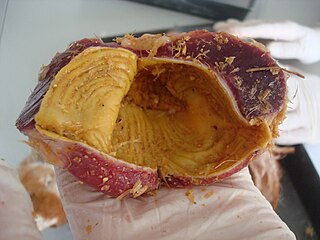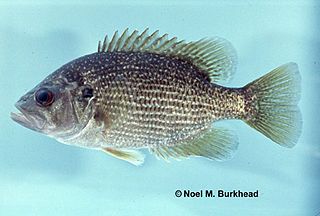
The gizzard, also referred to as the ventriculus, gastric mill, and gigerium, is an organ found in the digestive tract of some animals, including archosaurs, earthworms, some gastropods, some fish, and some crustaceans. This specialized stomach constructed of thick muscular walls is used for grinding up food, often aided by particles of stone or grit. In certain insects and molluscs, the gizzard features chitinous plates or teeth.

The marbled duck or marbled teal is a medium-sized species of duck from southern Europe, northern Africa, and western and central Asia. The scientific name, Marmaronetta angustirostris, comes from the Greek marmaros, marbled and netta, a duck, and Latin angustus, narrow or small and -rostris billed.

The Roanoke bass is a species of freshwater fish in the sunfish family (Centrarchidae) of order Perciformes. This species is endemic to rivers in the eastern United States of America, where it is native only to the states of Virginia and North Carolina.

Pope's Creek is a 5.3-mile-long (8.5 km) tidal tributary of the Potomac River in Westmoreland County, Virginia. The George Washington Birthplace National Monument lies along the north side of Popes Creek. Popes Creek landing is located at 38°11′29″N76°54′16″W.

Dorosoma is a genus that contains five species of shads, within the family Dorosomatidae. The five species are native to the North and/or Central America, and are mostly known from fresh water, though some may reside in the waters of estuaries and bays.

The American gizzard shad, also known as the mud shad, is a member of the herring family of fish and is native to large swaths of fresh and brackish waters in the United States of America, as well as portions of Quebec, Canada, and Mexico. The adult has a deep body, with a silvery-green coloration above fading to plain silver below. The gizzard shad commonly resides in freshwater lakes, reservoirs, rivers, and streams but can also reside in brackish waters, as it does on the Atlantic coast of the United States. Their range is across most of the continental United States, although they typically go no further north than New York and no further west than New Mexico. They are a large part of many of the ecosystems they inhabit and can drive changes in phyto- and zooplankton, thereby indirectly affecting other planktivorous fishes. The gizzard shad has been widely used as a food source for game fish, with varied success in management and effectiveness.

The skipjack herring is a North American, migratory, fresh- and brackish water fish species in the herring family Alosidae. The name skipjack shad comes from the fact that it is commonly seen leaping out of the water while feeding. Other common names include blue herring, golden shad, river shad, Tennessee tarpon, and McKinley shad. The skipjack shad is restricted to the Gulf of Mexico drainage basins. Skipjack are found in clear to moderately turbid water in areas with flow. Because they are a migratory species, dams often impede their reproduction. Records suggest that this species was much more abundant in the Upper Mississippi River basin before it was impounded. Currently, skipjack is most abundant in the Upper Mississippi River below the mouth of the Ohio River. They are known as an "early-run" species as they migrate to spawn in the early spring.

The allis shad is a widespread Northeast Atlantic species of fish in the Alosidae family. It is an anadromous fish which migrates into fresh water to spawn. It is found in the eastern Atlantic Ocean, the western Baltic Sea and the western Mediterranean Sea. In appearance it resembles an Atlantic herring but has a distinctive dark spot behind the gill cover and sometimes a row of up to six spots behind this. It sometimes hybridises with the twait shad. This fish becomes mature when three or more years old and migrates to estuaries, later swimming up rivers to spawn. Populations of this fish have declined due to overfishing, pollution and habitat destruction. Conservation of this species is covered by Appendix III of the Bern Convention and Appendix II and V of the European Community Habitats Directive.

Tenualosa is a genus of fish in the family Dorosomatidae. When subfamilies are recognized, it is placed in the subfamily Alosinae or Dorosomatinae.

The threadfin shad is a small pelagic freshwater forage fish common in lakes, large streams and reservoirs of the Southeastern United States. Like the American gizzard shad, the threadfin shad has an elongated dorsal fin, but unlike the gizzard shad, its mouth is more terminal without a projecting upper jaw. The fins of threadfin shad often have a yellowish color, especially the caudal fin. The back is grey to blue with a dark spot on the shoulder. D. petenense is more often found in moving water, and is rarely found deep in the water column. It occurs in large schools, sometimes with gizzard shad, and can be seen on the surface at dawn and dusk. The threadfin shad may reach lengths of 8 in (200 mm), but only rarely. This fish is very sensitive to changes in temperature and dissolved oxygen, and die-offs are frequent in late summer and fall, especially when water temperature drops to 42 °F. The threadfin shad is a favorite food for many game fishes, including striped bass, largemouth bass, smallmouth bass, and catfish. This fish is widely introduced throughout the United States as a forage for game fish.
Sardinella richardsoni is a species of ray-finned fish in the genus Sardinella from the South China Sea in the northwest Pacific.

The Pontic shad, also referred to as the Black Sea shad or Kerch shad, is a species of clupeid fish in the genus Alosa, native to the Black Sea and Sea of Azov basins.

Anodontostoma is a small genus of gizzard shads found in the Indo-Pacific region. It currently contains three described species.

Gonialosa is a genus of gizzard shads that are found in the rivers of South and Southeast Asia. There are currently three described species.
Konosirus punctatus is a species of fish in the family Dorosomatidae. It is the only member of the monotypic genus Konosirus. Its common names include dotted gizzard shad and konoshiro gizzard shad. It is native to the northwestern Pacific Ocean, where it occurs along the Asian coastline.

Nematalosa is a genus of gizzard shads in the fish family Dorosomatidae. There are currently 11 recognized species. They are mainly found in Indo-Pacific.

The Alabama shad is an anadromous species of alosid fish endemic to the United States where it breeds in medium to large flowing rivers from the Mississippi River drainage to the Suwannee River, Florida, as well as some other Gulf coast drainages. The biology of this fish is little known but it has become increasingly rare. The International Union for Conservation of Nature rated it "near threatened" in 2020 and the United States National Marine Fisheries Service has listed it as a Species of Concern. A principal reason for its decline is thought to be the many locks and dams blocking access for the fish to up-river spawning grounds.

The Bloch's gizzard shad, also known as gizzard shad, hairback, long-finned gizzard shad, long-ray bony bream and thread-finned gizzard shad, are a widespread and common, small to medium-sized anadromous fish found in all marine, freshwater and brackish waters throughout Indo-West Pacific, towards eastward of Andaman Sea, South China Sea and the Philippines to Korean peninsula. Single specimen recorded from waters of South Africa. It was described by Marcus Elieser Bloch in 1795.

Anodontostoma chacunda or Chacunda gizzard shad is a small species of gizzard shad found in both fresh and marine waters. The fish is from the family Clupeidae.
Nematalosa flyensis, the Fly River gizzard or Fly River gizzard shad, is a species of freshwater ray-finned fish within the family Clupeidae. The species is endemic to New Guinea, and is only known to inhabit the Fly River, including its tributary Strickland River.















